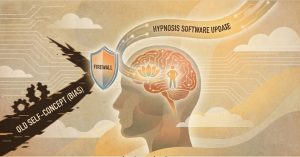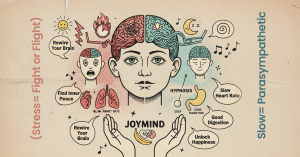Introduction: The Power of the Mind
The human mind is an incredible machine, capable of influencing every aspect of our lives. It determines how we think, feel, and act. But what if we could consciously tap into this power? What if we could unlock the hidden potential lying dormant in our subconscious, break through limiting beliefs, and create lasting positive change? This is where Neuro-Hypnotherapy comes in—a transformative process that combines the art of hypnosis with the science of neuroscience to help individuals achieve personal growth and well-being.
At Joymind, Neuro-Hypnotherapy is a unique, research-backed method designed to help you access deeper parts of your mind, rewire your thinking patterns, and bring about meaningful transformations. While hypnosis might sound mysterious or even intimidating to some, it’s actually a simple, natural process that has been used for centuries. With advances in neuroscience, we now understand more about how hypnosis works in the brain, allowing us to leverage its benefits more effectively than ever before.
In this article, we’ll walk you through how Joymind’s Neuro-Hypnotherapy process works, breaking it down into three key stages: Awareness, Reprogramming, and Transformation. We’ll explore how each phase is not just a mental exercise, but a scientifically grounded method to help you unlock creativity, overcome anxiety, and break free from limitations. Whether you’re looking to address specific issues or simply enhance your overall well-being, this journey through Neuro-Hypnotherapy can offer profound insights and lasting change.
Step 1: Awareness—Discovering the Inner Workings of Your Mind
The first stage in Joymind’s Neuro-Hypnotherapy is Awareness. This phase is all about observing your thoughts, emotions, and bodily sensations without judgment. It may sound simple, but it’s one of the most powerful tools you can use to understand your own mind. Much of our mental activity operates below the level of conscious awareness. We often go through life on autopilot, reacting to situations based on ingrained habits, past experiences, or learned beliefs.
In Neuro-Hypnotherapy, the goal of the Awareness stage is to slow down and step outside of these automatic responses. By doing so, you become a curious observer of your own inner world, noticing thoughts and feelings as they arise. Instead of letting your mind run on a continuous loop of stress, anxiety, or self-doubt, you gain a clearer perspective of what’s really happening inside.
Here’s how this phase works in practice. During a hypnotherapy session, your hypnotherapist will guide you into a deeply relaxed state. This is not about “putting you to sleep” or making you unconscious; it’s more like being in a state of heightened focus and relaxation, similar to daydreaming. In this state, you’re more open to suggestions and more aware of subtle thoughts and feelings that you might not notice in your day-to-day life.
This state of awareness has profound benefits, particularly for overcoming mental blocks and gaining insight into your own behaviors. Research has shown that hypnosis can significantly alter conscious awareness, helping people recall forgotten memories or experience feelings they have suppressed. This is why Neuro-Hypnotherapy is so effective in helping clients confront fears, doubts, and emotional pain that they may not even realize they’re holding onto.
Through guided techniques, Joymind’s Neuro-Hypnotherapy helps you become aware of limiting beliefs that are holding you back—beliefs like “I’m not good enough” or “I’ll never succeed.” When these beliefs come into the light of awareness, they lose their power over you. You can observe them from a neutral position rather than being controlled by them.
The Awareness phase is critical because it sets the stage for the next part of the process: Reprogramming.
Step 2: Reprogramming—Creating New Pathways in the Brain
Once you’ve gained a clearer understanding of your inner world, the next step in Neuro-Hypnotherapy is Reprogramming. In this phase, you take the insights you’ve gained and start to replace unhelpful patterns of thinking and behavior with healthier, more empowering ones. If Awareness is about understanding the landscape of your mind, Reprogramming is about actively reshaping it.
Reprogramming might sound complicated, but at its core, it’s based on a simple fact: the brain is changeable. In neuroscience, this is known as neuroplasticity—the brain’s ability to form new connections and rewire itself in response to experience. Every time you learn something new or change how you react to a situation, your brain is literally being reprogrammed.
This is where hypnosis becomes a powerful tool. During hypnosis, the mind becomes more flexible and open to new suggestions. By accessing the subconscious directly, we can bypass the rigid, critical thinking that often stops us from changing deep-rooted habits and beliefs. This allows for deep-level reprogramming to occur, where you can install new thought patterns, perspectives, and behaviors that support your goals and well-being.
Let’s look at an example. Imagine you struggle with anxiety and find yourself constantly worrying about the future. In the Reprogramming phase of Neuro-Hypnotherapy, your hypnotherapist would guide you through exercises designed to help you develop more helpful thought patterns. Instead of feeling overwhelmed by anxious thoughts, you might learn to replace them with a sense of calm confidence or a focus on the present moment.
The real beauty of this phase is that the changes aren’t just mental—they’re neural. By repeating new, positive suggestions during hypnosis, you’re training your brain to think in new ways. Over time, these new patterns become automatic, much like learning a new habit. The more you practice, the stronger these neural pathways become, eventually replacing the old, limiting ones.
Neuro-Hypnotherapy is particularly effective for issues like:
- Reducing stress and anxiety
- Overcoming phobias
- Boosting self-confidence
- Enhancing creativity
- Letting go of negative habits (like smoking or overeating)
Reprogramming helps you create the kind of mind that works for you, rather than against you. By the end of this stage, you’re not just aware of your thoughts—you’re actively shaping them.
Step 3: Transformation—Becoming the Best Version of Yourself
The final phase of Joymind’s Neuro-Hypnotherapy process is Transformation. This is where all the work you’ve done in the Awareness and Reprogramming phases comes together, allowing you to step into a new version of yourself. If Awareness is about understanding your mind and Reprogramming is about reshaping it, Transformation is about living in alignment with the person you want to be.
In this stage, you consolidate the new beliefs and behaviors you’ve created, making them an integrated part of your life. You’ll begin to notice subtle but powerful changes in how you think, feel, and act. Situations that once caused you stress or anxiety may no longer have the same effect, because you’ve trained your mind to respond differently. You might find yourself naturally more creative, confident, or resilient.
Transformation is often described as a state of flow, where you’re fully engaged in life and feel in sync with your goals and desires. In this state, creativity flows more easily, and challenges feel less daunting because you’re operating from a place of inner strength and clarity.
This phase is closely connected to the concept of brain plasticity, the brain’s ability to keep changing and adapting throughout life. Hypnosis helps facilitate this change by creating an environment where the brain is more open to new possibilities. In essence, Neuro-Hypnotherapy gives you the tools to continue evolving, even after the sessions are over.
Many people find that Neuro-Hypnotherapy not only helps them overcome specific issues but also leads to personal growth in unexpected areas. You might discover new passions, develop a deeper connection with others, or feel more aligned with your true purpose. Transformation doesn’t just mean fixing problems—it means unlocking your potential and living a more fulfilling life.
The Science Behind Joymind’s Neuro-Hypnotherapy
You might be wondering, “How does this all work on a biological level?” While hypnosis may seem mystical, it’s actually grounded in well-established neuroscience. When you enter a hypnotic state, certain areas of the brain—like the prefrontal cortex, which is involved in decision-making and self-awareness—become more active. At the same time, regions responsible for habits and automatic responses become less active, allowing for greater cognitive flexibility.
Studies have shown that hypnosis can:
- Alter brain activity in areas related to pain perception, helping reduce the sensation of pain.
- Enhance memory recall or suppress painful memories, giving people greater control over their emotional experiences.
- Boost neural flexibility, making it easier to form new habits and perspectives.
Joymind’s Neuro-Hypnotherapy taps into these scientifically validated principles to help you achieve lasting change. By combining ancient wisdom with modern neuroscience, we’re able to offer a transformative process that’s both powerful and grounded in research.
Conclusion: A New Path to Personal Transformation
Neuro-Hypnotherapy offers a unique opportunity to tap into the untapped power of your mind. Whether you’re looking to reduce anxiety, overcome creative blocks, or simply improve your well-being, this process provides a structured and effective way to create real, lasting change.
At Joymind, we believe in the potential of every individual to transform their life. With the right tools and support, you can reprogram your mind, overcome limitations, and become the best version of yourself. The journey through Awareness, Reprogramming, and Transformation is one that can unlock doors you never thought possible.
Are you ready to begin your journey? Let Neuro-Hypnotherapy guide you toward the life you deserve.
References
Kihlstrom, J. F. (2012). Neuro-Hypnotism: Prospects for Hypnosis and Neuroscience. Cortex, 49(2), 365-374. https://pmc.ncbi.nlm.nih.gov/articles/PMC3528837/
Glock, M. (2021). 3-Step Breakthrough Method. Joymind. Retrieved from https://joymind.com
















